#Top of the Pyramids: Ancient Egyptian Civilization Exhibition
Explore tagged Tumblr posts
Text









#Shanghai Museum#Meow Night#The Secrets of Saqqara#Ancient Egypt#ancient egyptian relics#Bastet#cat mummies#cat statues#cats#felines#exhibition#Top of the Pyramids: Ancient Egyptian Civilization Exhibition#Saqqara#egyptian mummy
12 notes
·
View notes
Text
@cairo-top-tours
3 notes
·
View notes
Text
Discover the Wonders of Cairo and Giza: A Day Trip to Egypt's Top Tourist Attractions

If you're planning a visit to Egypt, a Cairo and Giza day trip is an absolute must. This fascinating journey will immerse you in the rich history and stunning landmarks that have made Egypt a top travel destination for centuries. From the awe-inspiring Pyramids of Giza to the bustling streets of Cairo, this one-day tour offers an unforgettable experience.
Explore the Iconic Pyramids of Giza
The highlight of any Cairo and Giza day trip is, without a doubt, the Pyramids of Giza. Standing tall on the outskirts of Cairo, these ancient structures have captivated travelers for thousands of years. The Great Pyramid of Khufu, the largest and most famous of the three, is one of the Seven Wonders of the Ancient World. Whether you're marveling at their sheer size, exploring their mysterious interiors, or taking a camel ride around the desert, the Pyramids are sure to leave you speechless.
Visit the Sphinx: A Mysterious Monument
Next, head to the legendary Sphinx, a colossal stone statue with the body of a lion and the head of a Pharaoh. Guarding the Pyramids, the Sphinx has stood the test of time, preserving its mystique and allure. A visit to this monument is a chance to dive deeper into the mysteries of ancient Egyptian civilization and mythology.
Discover the Egyptian Museum in Cairo
No trip to Cairo is complete without a visit to the Egyptian Museum, which houses an extraordinary collection of ancient Egyptian artifacts. Among its most famous exhibits are the treasures of King Tutankhamun, including the golden death mask and other priceless relics. With more than 120,000 items on display, the museum is a treasure trove of Egypt’s glorious past.
Stroll Through Cairo's Historic Streets
In addition to the ancient wonders, Cairo itself is a vibrant city full of history, culture, and charm. Take a walk through the bustling markets of Khan El Khalili, one of the oldest bazaars in the world, or visit the Al-Azhar Mosque, a symbol of Islamic architecture and scholarship.
Why Choose a Day Trip to Cairo and Giza?
A Cairo and Giza day trip offers a perfect balance of ancient history and modern-day experiences. Whether you're a history enthusiast, a photography lover, or simply someone who enjoys exploring new cultures, this tour has something for everyone. By booking your day trip with Egypt Tours, you can be sure that you'll experience Egypt in comfort and style, with expert guides to enrich your journey.
0 notes
Text
Top 10 Must-See Attractions and Essential Tips for Visiting the Louvre Museum in Paris
0 notes
Text
Traveling from Hurghada to Cairo
Traveling from Hurghada to Cairo opens up a wealth of historical, cultural, and adventurous experiences. Here are ten top trips and activities you can enjoy in Cairo:
**1. Pyramids of Giza and Sphinx
Overview: No trip to Cairo is complete without visiting the iconic Pyramids of Giza and the Sphinx.
Highlights:
Great Pyramid of Giza: Explore the last surviving wonder of the ancient world.
Sphinx: Admire the mythical statue guarding the pyramids.
Optional Camel Ride: Experience a camel ride around the pyramids for a more authentic feel.
**2. Egyptian Museum
Overview: Home to an extensive collection of ancient Egyptian artifacts, the Egyptian Museum is a treasure trove of history.
Highlights:
Tutankhamun Exhibit: View the treasures of Tutankhamun, including his famous gold mask.
Mummies Room: See the mummies of ancient Egyptian royalty.
Artifacts Collection: Explore a wide array of statues, jewelry, and everyday items from ancient Egypt.
**3. Cairo Citadel
Overview: This historic fortress offers panoramic views of Cairo and houses several important mosques.
Highlights:
Mohammed Ali Mosque: Also known as the Alabaster Mosque, it's one of Cairo’s most recognizable landmarks.
National Military Museum: Learn about Egypt’s military history.
Views of Cairo: Enjoy spectacular views of the city from the citadel’s ramparts.
**4. Khan El Khalili Bazaar
Overview: A vibrant market in the heart of Cairo where you can shop for souvenirs, spices, and traditional crafts.
Highlights:
Shopping: Browse through a wide range of goods including jewelry, textiles, and antiques.
Cafes and Restaurants: Relax in a traditional café and sample local delicacies.
Traditional Atmosphere: Experience the bustling, colorful environment of this historic market.
**5. Coptic Cairo
Overview: Explore the historic Coptic district of Cairo, which is rich in religious history.
Highlights:
Hanging Church (Saint Virgin Mary's Coptic Orthodox Church): Visit this ancient church built atop Roman walls.
Coptic Museum: Discover a collection of Christian artifacts and manuscripts.
Saint Sergius and Bacchus Church: Known for its historical significance and religious artifacts.
**6. Old Cairo (Islamic Cairo) Walking Tour
Overview: Wander through the historic streets of Islamic Cairo to discover its rich architectural and cultural heritage.
Highlights:
Historic Mosques: Visit mosques such as Al-Azhar and Sultan Hassan.
Historic Buildings: Explore ancient houses, narrow streets, and old markets.
Local Culture: Experience the daily life and culture of Cairo’s old neighborhoods.
**7. Day Trip to Memphis and Saqqara
Overview: Explore the ancient capital of Memphis and the nearby Saqqara necropolis, home to the Step Pyramid of Djoser.
Highlights:
Memphis: Visit the open-air museum featuring statues of Ramses II and other artifacts.
Saqqara: Explore the Step Pyramid and the surrounding tombs.
Ancient Ruins: Discover the remnants of ancient Egyptian civilization.
**8. Nile River Cruise
Overview: Enjoy a relaxing cruise on the Nile River with dinner and entertainment.
Highlights:
Dinner Cruise: Savor a meal while cruising along the Nile.
Live Entertainment: Enjoy traditional music and dance performances.
Scenic Views: Admire the illuminated Cairo skyline from the river.
**9. Giza Solar Boat Museum
Overview: Located near the Great Pyramid, this museum houses the reconstructed ancient solar boat of Khufu.
Highlights:
Solar Boat: View the impressive boat that was buried with the pharaoh for use in the afterlife.
Historical Insight: Learn about the significance of the solar boat in ancient Egyptian rituals.
**10. Day Trip to Alexandria
Overview: If you have extra time, consider a day trip to Alexandria, located on the Mediterranean coast.
Highlights:
Bibliotheca Alexandrina: Explore the modern library and its museum.
Qaitbay Citadel: Visit this historic fortress built on the site of the ancient Lighthouse of Alexandria.
Roman Amphitheater: Discover the remains of the ancient Roman theater and its surrounding ruins.
Best Holidays in Hurghada
Best Spa Experience in Hurghada
safari Hurghada
Spa in Hurghada
Best 10 trips From Hurghada To cairo
Egypt offers some incredible safari experiences
Tips for Traveling from Hurghada to Cairo:
Transportation: Consider booking a private transfer, taking a bus, or flying for a quicker journey.
Tour Packages: Many tour operators offer packages that include transportation, guided tours, and entry fees.
Plan Ahead: Check the opening hours and any required tickets for attractions you plan to visit.
These trips offer a diverse range of experiences, from ancient wonders and historical sites to vibrant markets and relaxing cruises. Enjoy your journey from Hurghada to Cairo!
0 notes
Text
Opening of the exhibition "the summit of the Pyramid: The Civilization of Ancient Egypt" exhibition at the Shanghai National Museum in China
Discover the greatness of Egypt with Egypt tours and explore a Cairo Day trips, within the framework of the policy pursued by the Ministry of Tourism and Antiquities to establish many temporary archaeological exhibitions abroad as a window for all peoples of the world to learn about the ancient Egyptian civilization and the genius of the ancient Egyptian and his creativity in science, engineering, arts and other fields that help reconcile peoples and their different cultures and beliefs, Dr. Mohamed Ismail Khaled, Secretary General of the Supreme Council of Antiquities, opened the exhibition "Top of the Pyramid: The Civilization of Ancient Egypt" exhibition at the Shanghai National Museum in Shanghai, People's Republic of China.
The opening was witnessed by Zhao Jiaming, member of the Standing Committee and head of the Propaganda Department of the CPC Committee of Shanghai Municipality, Liu Duo, deputy mayor of the government of Shanghai Municipality, ambassador Assem Hanafi, ambassador of Egypt to the people's Republic of China, Ambassador Mohammed Ruslan, consul general in Shanghai, Luo Wenli, director general of the National Administration of cultural heritage, and many representatives of cultural institutions in China, Arab and foreign countries.
Dr. Mohamed Ismail Khaled explained that since the first hours of the opening of the exhibition, it has enjoyed an unprecedented public turnout in China, where all tickets for the first day have been sold out and 250 thousand tickets have been sold so far, pointing out that this exhibition, although it is not the first of its kind in China, it is the largest since 2003, and it will contribute significantly to promoting the Egyptian tourist destination, especially the cultural tourism product in the Chinese market, which is one of the most important target markets.


Enjoy the great beauty of the Nile River with Egypt Nile Cruise Tours or explore the rich history with Egypt Classic Tours. For those who are looking for a unique experience in this season. The exhibition includes (787) artifacts carefully selected from the holdings of several ancient Egyptian archaeological museums to highlight the greatness of the ancient Egyptian civilization since its inception from the Naqada period and the eras of the beginning of the dynasties to the modern state, as it illustrates the idea of ownership, daily life, decorations and ornaments, writing, religious beliefs, and the other world of the ancient Egyptian, through the display of a distinguished collection of and Egyptian idols such as Osiris, Isis, Bastet, Hathor, the calf APIs and jati, in addition to a set of gold and stone-encrusted bracelets، Pots, crowns, and Royal cartridges, in addition to some pieces that express the idea of the other world of the ancient Egyptian, including a distinguished collection of colorful wooden coffins and canopic Ware.
According to the scenario of the exhibition, the artifacts were distributed to three main halls: the hall "Land of the Pharaohs", "Secrets of Saqqara" and "the age of Tutankhamun". the exhibition will last until August 2025. We offer a Egypt Easter Tours. Our Egypt travel packages cater to all your needs, including Egypt shore excursions for sea travelers. Join us for an unforgettable journey!

0 notes
Text
Unique Experiences on Cairo Day Tours
Cairo, the vibrant heart of Egypt, offers a treasure trove of experiences for travelers eager to explore its rich tapestry of history, culture, and modernity. From the grandeur of ancient pyramids to the bustling streets of the modern city, Cairo day tours promise a captivating blend of old and new. This article delves into unique experiences that cater to different types of travelers, whether you’re a history enthusiast, a culinary adventurer, an art lover, or traveling with family. Each curated experience is designed to make your visit unforgettable, showcasing why Cairo remains a top destination for those exploring Egypt.
Exploring the Old Kingdom: A Must-Do for Egypt Day Tours
A Cairo day tour is incomplete without a journey into the Old Kingdom of Egypt. The Giza Pyramid Complex, with its iconic Sphinx and the majestic pyramids, stands as a testament to Egypt’s ancient architectural prowess and cultural depth. Beyond Giza, Saqqara and Dahshur offer a quieter, more introspective look at pyramid evolution, where the Step Pyramid of Djoser and the Bent Pyramid provide insight into the architectural experiments that shaped ancient Egyptian civilization. These sites not only reflect historical and engineering marvels but also offer a palpable sense of history that connects visitors to the past rulers and their eternal quest for immortality.
The Hidden Corners of Cairo: Unique Stops in Private Day Tours Egypt
Private day tours in Cairo allow for a deeper exploration of the city’s lesser-known gems. The Coptic Quarter, with its winding alleys and historic churches, tells the story of a different Cairo, dating back to the early days of Christianity. The Hanging Church and the Coptic Museum are highlights, offering unique insights and artifacts. Another hidden gem is the City of the Dead, a vast Islamic necropolis that functions as both a cemetery and a residential area. Here, guided tours can uncover beautifully detailed mausoleums and the daily lives of people residing among centuries-old tombs, providing a truly unique perspective of Cairo.
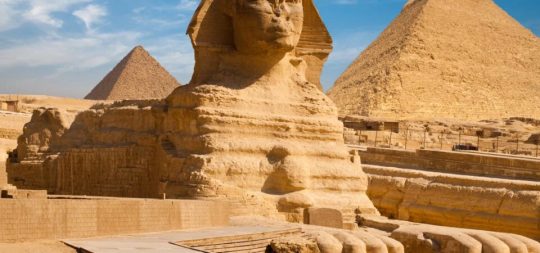
Culinary Delights: Gastronomic Adventures on Cairo Day Tours
Cairo’s culinary scene is a vibrant mix of flavors that tells the story of Egypt’s complex history. A culinary tour can start in the bustling lanes of Khan El Khalili, where traditional coffee shops and shisha bars offer a taste of local life. Sampling street food like koshari, a mix of pasta, rice, lentils, and fried onions, or savory snacks such as falafel and shawarma, introduces the basic staples of the Egyptian diet. For the more adventurous, upscale dining experiences that fuse modern cooking techniques with traditional flavors can be found in Zamalek and Downtown Cairo, showcasing how the city’s food scene is as dynamic as its history.
Art and Culture in the Capital: Diverse Attractions in Egypt Private Tours
Cairo is not just about ancient Egypt; the city’s vibrant contemporary art scene is an essential part of any cultural tour. The Townhouse Gallery and Darb 1718 feature works by modern Egyptian and international artists, providing insight into the current socio-political landscape through visual arts. Private tours can also include visits to the Cairo Opera House or a traditional music and dance performance at the Makan Egyptian Center for Culture and Arts. These experiences offer a deeper understanding of Egypt’s rich artistic heritage and its thriving modern cultural expressions.
Family Adventures in Cairo: Engaging Activities for Egypt Family Tours
For families traveling with children, Cairo offers exciting and educational experiences that engage young minds and provide fun for the whole family. The Pharaonic Village offers a hands-on historical experience where families can learn about ancient Egyptian life through interactive exhibits and live demonstrations. The Cairo Zoo and the Aquarium Grotto Garden provide a more relaxed atmosphere where kids can learn about local and exotic wildlife. Additionally, many family tours include felucca rides on the Nile, which can be a delightful way for the whole family to see the city from a different perspective.
Cairo offers an array of experiences that can satisfy every type of traveler. From its historical pathways that take you back in time to its culinary delights that excite your taste buds, from its hidden corners that reveal lesser-known stories to its vibrant art scene that pulses with contemporary life, Cairo is a city that never ceases to amaze. The experiences highlighted here provide just a glimpse of what Cairo has to offer.
Ready to explore the wonders of Cairo with experiences tailored just for you? Book your daily tours in Egypt with Love Egypt Tours agency today and discover the rich tapestry of Cairo’s cultural, historical, and culinary delights. Whether you are looking for a private, personalized tour or an engaging family adventure, Love Egypt Tours offers the expertise and local knowledge to make your trip unforgettable. Don’t wait, book now and take the first step on an incredible journey through Cairo!
0 notes
Text
Discovering Egypt's Treasures: 5 Essential Activities for Your Trip
Egypt is a land of dreams. Egypt can only be described in one way: it is epic. Egypt, the former home of the Pharaohs, is a fascinating location with magnificent buildings and tombs that astound all tourists.
The Pyramids of Giza, a River cruise, and the Luxor archaeological finds are frequently on the must-see lists of first-time tourists to Egypt. But Egypt has a lot of more thrilling activities to offer.
Not only the historic treasures, but Egypt is also known for its vast tracts of desert landscape, pristine coral reefs, the life-giving Nile and superb scuba diving in the Red Sea or hiking to the top of Mount Sinai, and luxurious resort towns. Egypt provides something for everyone in terms of history, culture, sand and sun, prehistoric civilization, and archaeological wonders.
A 5- to 8-day Egypt vacation package is good enough to discover some of the best you like to experience in Egypt. In such a short trip, you should start with Cairo and visit the Pyramids, Alexandria, Luxor, and much more. There are hundreds of things to do & places to visit in Egypt... Let's find out the five best places to explore on an Egypt trip package!

Go to the Giza pyramids
One of the most well-known landmarks in the world is the Pyramids of Giza, which are joined by the Sphinx and a few other smaller monuments. The Great Pyramid of Giza was built almost 5,000 years ago. Of the Seven Wonders of the Ancient World, it is the oldest. Spend no less than three hours visiting the Giza Pyramids. It will give you enough time to go inside the Great Pyramid territory, visit Panoramic Point and snap a photo with the Sphinx.
Cruise on the Nile river
One of the best things to do in Egypt is to drift down the Nile River past the ruins of temples and tombs. Most cruises make stops at Esna, Edfu, and Kom Ombo while en route from Aswan to Luxor. You can travel the Nile River by cruise ship, on a dahabiya (smaller wooden ship), or a felucca (a small, Egyptian sailboat).
Explore the historic city of Cairo
Egypt's capital is Cairo. Just when the desert changes into the Nile Delta, it is situated on the Nile River. It is the historic heart of Cairo and contains one of the largest collections of historic architecture in the Islamic world. Numerous mosques, madrassas, fortifications, and tombs date from the Islamic era making Cairo one of the world’s oldest Islamic cities. Among the top attractions in Islamic Cairo are the Al-Azhar Mosque, Salah El-Din Citadel, a stroll down Al-Muizz li-Din Allah al-Fatima Street (also known as al-Muizz), shopping in Khan el-Khalili, and the Al-Rifa'i Mosque.
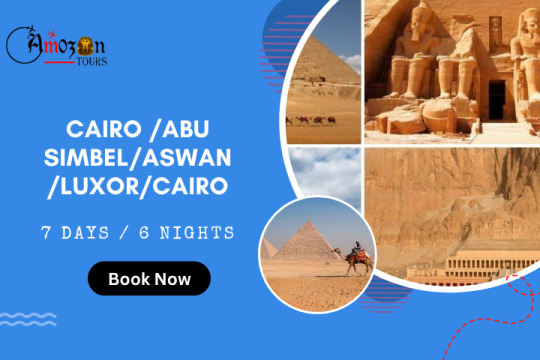
Abu Simbel Temples:
Another popular tourist destination in Egypt is Abu Simbel, which is worth the trip. A popular tourist destination among the many things to do in Egypt, it is a 3- to 4-hour journey from Aswan. View the two colossal 13th-century rock-cut temples of Abu Simbel. The first temple is a monument dedicated to Queen Nefertari and King Ramesses II, whose four huge statues guard the entrance. There are eight more of these enormous statues depicting Rameses II as the ruling deity inside the monument.
Egyptian Museum:
Everyone agrees that the Egyptian Museum is located in Tahrir Square in Cairo. Visiting here is the normal must-do among things to do in Egypt. You may spend hours studying history, people, music, science, and hieroglyphs. Besides collections of age-old artifacts, preserved animal and human mummies, carvings, and statues that can easily fill you with awe!
Amazon Tours offer numerous exciting Egypt tours and packages. It allows tourists to witness the glamorous chaos of Egyptian streets and exhibit the perfect blend of ancient, medieval, and modern cities. It will cover all the major attractions of this lively city. They provide the perfect opportunity to experience sheer comfort and luxury on a hassle-free vacation. Call them on 00201090705402 today to know more about their service and Egypt tours and packages.
0 notes
Text
Egypt's Top Tourist Attractions to Visit During the Holidays

Egypt is the birthplace of the world's most famous ancient civilization, the Pharaohs; Be awed by the greatness of the ancient Egyptians by booking an Egypt tour package.
Nile River Cruises
Nile Cruises are at the top of everyone's list of must-do activities when visiting Egypt, so it's no surprise that they are frequently sold out, especially around the holidays. Nile Cruises is a must-see for visitors because of its good atmosphere and luxurious food, as well as its fantastic Christmas and New Year party members, local enjoyment, games, songs, and a number of other activities. The cruise cabins ensure that all guests have a luxurious experience, with high-quality service and housekeeping.
Giza's Pyramids
The Giza Pyramids will captivate you, especially during the holiday season. Pyramids are synonymous with the name Egypt; they were the center of the ancient Egyptian civilization and are regarded as significant evidence of that era's great architecture. The huge aspects of the great pyramid, particularly those at Giza, Khufu, Khafre, and Menkaure, have always been and will continue to be enticing to the billions and billions of tourists who visit Egypt every year. also can enjoy a festive Christmas in Egypt while learning about the incredible Pyramids and the wonderful Sphinx in Cairo. The Giza pyramids' light and sound show will undoubtedly astound you as well as provide an overview of ancient Egyptian culture and history.
The Egyptian Museum
The Egyptian Museum in Cairo, also known as "the Museum of Ancient Egyptian Artifacts," is considered a landmark in Egypt. The museum witnesses and houses the world's most magnificent and comprehensive collection of ancient Egyptian artifacts and monuments, dating back over 3,000 years in Egypt, from the Old Kingdom to the Roman era. The museum's ground floor is organized chronologically, clockwise from the entry hall, whereas exhibits on the first floor are organized thematically. There is a hidden treasure that you should not miss while visiting the museum. Room 14 on the first floor houses a wonderful collection of Graeco-Roman mummies known as the Fayoum Portraits, which feature amazing artistic and brilliantly executed face masks.
The City of Luxor
Luxor is a popular destination for Egyptian tourists, especially during the Christmas season. Luxor, dubbed "the world's greatest open-air museum," is home to an intriguing mix of ancient ruins, temples, and tombs. East and West banks divide Luxor. The East bank represented the land of the living, where the sun rose and people prospered, while the West bank represented the land of the dead, where the sun set and people embarked on their journey to the afterlife. Temples and tombs dot the West Bank, where the public and rulers were buried to begin their afterlife journey, as ancient Egyptians believed.
Wanna read the entire blog? Go here Now!
0 notes
Text
Blood Incantation - Hidden History of the Human Race

Blood Incantation’s fans are almost as rabidly obsessed as I and many other fans of Meshuggah are about our favorite Swedish metalheads, and this was while the Denver-based four-piece had only released their half-hour-long 2016 debut, Starspawn. The band’s debut was an indeed impressive record whose intrigue lied not so much in being so radically far above the rest of the techdeath crop in terms of technicality alone, but rather by its dynamic composition and ability to incorporate a level of unsettling spaciness that would at first seem difficult to weave into the tight seams of technical death metal. While I was not quite as overcome by its glory to the same degree the band’s devout fans were or as enamored with it as I am with Meshuggah’s knack for technical groove, I understand the admiration for what the band are able to do with technical death metal, and I imagine that the band’s fan base is up in a frenzy of jubilee right now, because Hidden History of the Human Race is an even more accomplished exhibition of the band’s clearly matured unique style of technical death metal than its already impressive predecessor.
Like the preceding debut, the band’s sophomore effort is a relatively short (thirty-six-minute) affair with just a few tracks, but that’s because the band make every move they make across the album’s four intricately composed and clearly thoroughly nurtured songs.
The first half of the album is comprised of the first three tracks: “Slave Species of the Gods”, “The Giza Power Plant”, and the instrumental “Inner Paths (To Outer Space)”. The second half of the record is taken up entirely by the epic “Awakening from the Dream of Existence to the Multidimensional Nature of Our Reality (Mirror of the Soul)”.
In true sci-fi techdeath fashion, the album’s lyrics fixate on the pseudoarchaeological speculations of intelligent extraterrestrial involvement in the formation of human civilization, with a clearly over-the-top tone to ensure one the band knows what they’re writing about is purely fun and fictional and like the auto-mind-blown epiphanies and hypothesizing of a guy who’s smoked a whole bowl of some really good weed. “Slave Species of the Gods” focuses on cosmic gnostic mythology surrounding Yaldabaoth and humans being trapped in exactly the scenario the title implies. “The Giza Power Plant”, which implies that the great pyramids of Giza (a frequent topic of psuedohistorical speculation) were secretly part of an ancient high tech power plant continues this speculation on “a past that never happened” and the interweaving of divergent multiverse timelines that opens the doors to the possibility of “alien histories”. It’s fuckin’ third-eye-open woke as fuck, and after the brief instrumental break of the aptly meditation-inducingly titled “Inner Paths (To Outer Space)”, the title of the epic closing track, “Awakening from the Dream of Our Existence to the Multidimensional Nature of Our Reality (Mirror of the Soul)”, really says it all. Across its musings on that multidimensional reality, the song invokes the gnostic demons (Archons), the ancient Egyptian mythological deity of writing (Thoth), and the speculative pseudoscientific and pseudohistorical concept of the halls of Amenti (where record of humankind’s hidden history are supposedly kept).
Now I know I’ve kind of been a bit teasing and laughing along to the hyperwoke existential speculations on extradimensional divinity and multiverse theory, but I want to make clear that I’m not saying the entire subject is invalid or has no point being discussed. It’s certainly fascinating and the subject of lots of wild and thoughtful hypothesizing by both astrophysicists and college freshmen. The discussion on the subject of course has been hijacked by haphazardly hypothesizing pseudoscientists and pseudoarchaeologists for the rich benefits of the sheer entertainment value of the outlandishness of the claims, and it is indeed pretty hilarious seeing the lengths they continue to go to sustain their flow of entertainment. The band clearly are aware of this and only play into this subject material to enhance their similarly entertaining (though not guised as anything but) sci-fi techdeath. And for all its grand and absurdly specific pseudoarchaeological lore, the album is rewardingly thought-provoking and a creative reminder of the endless possibilities of our universe that our young civilization has yet to crack the surface of, without really claiming to hold the keys to the supposed hidden history its title references, because it is clearly, you know, sci-fi.
Okay, now onto the music.
Blood Incantation do not mess around in this album, and the meticulous attention to stylistic and compositional detail that made Starspawn so captivating is here in spades as well. The band play their intricate and organic brand of progressive technical death metal with chemistry as tight as ever and a compositional knack for pushing progressive bounds on full display, levitating their winding death metal into fittingly spacy, psychedelic realms.
“Slave Species of the Gods” kicks the album off with fat riffs and angular blast beat passages broken up by Kolias-esque fills and spacy guitar soloing that makes the song feels as though it’s floating up through the clouds and nearly escaping the atmosphere, which the later tracks most certainly do. But on the opener her, the band flex their performative muscles through delicious guitar solos (often warped by this hazing effect to give them this sort of space rocketing sound), tasty bass leads, and dazzling drum fills around thought fully arranged
“The Giza Power Plant” continues with the grisly, angular techdeath relentlessness the first song set as precedent, offering a little more atmospheric dissonance early on this time around, but the song breaks into the album’s first real psychedelic passage with the opening blasting and riffing crashing into a much calmer clean guitar section about two minutes in that gradually cascades into grander heavier instrumentation that expands and even contracts in all directions via all members’ dwelling and diminishing intensities and showinesses seemingly chaotically, but the path to the song’s grand climax of wild techdeathery becomes clearly geniusly planned out.
In contrast to its two preceding tracks, the lyricless “Inner Paths (To Outer Space)”, starts from space-like ambiance and takes a more psychedelic ride through rhythmic technicality to smoothly transition into the more metallically heavy and meditatively deathly body of the track before fading out just as smoothly into spacy psychedelia.
Taking up the entire second side of the album, the epic closing track “Awakening from the Dream of Existence to the Multidimensional Nature of Our Reality (Mirror of the Soul)” weaves through far too many movements to be adequately summarized by a single paragraph. But what can be said is that the massive song certainly matches the other three that collectively make up the album’s other half in compositional intricacy, performative technicality, and seamless segues into and out of more cosmically atmospheric psychedelic sections from their mostly flashy and dynamically pummeling technical death metal. And that techy death metal itself is hard to sum up as the band work in jazzy guitar solos, hardcore-flavored harmonics, double-bass swells and falls, slightly black metal-esque atmospheric dissonance, doomy sludge guitar passages, and equal opportunity drumhead and cymbal abuse of all varieties. It’s a thrilling ride all the way through to the soothing, yet needed, meditative end.
Blood Incantation really have outdone themselves on this album here, amplifying what hooked so many on their 2016 debut and what makes them such a compelling act. Hidden History of the Human Race is one of technical progressive death metal’s most stylistically and conceptually creative albums, not just of this year, but this decade. The band may not be churning out tons of material too quickly, but they’re certainly spending their time well, honing their craft and perfecting their sound quickly over the course of their short full-length projects, of which their sophomore album here is anything but one of those dreaded slumps. Needless to say, I’m beginning to feel myself sucked by the immense gravitational pull of the band’s giant, heavy, monolithic sound into that base of fans that so many others have been pulled into, and I’m very excited for what the future has in store for Blood Incantation.
Ancient Aliens: The Album/10
#Blood Incantation#Hidden History of the Human Race#Slave Species of the Gods#The Giza Power Plant#Inner Paths (To Outer Space)#Awakening from the Dream of Existence to the Multidimensional Nature of Our Reality (Mirror of the Soul)#technical death metal#progressive death metal#techdeath#death metal#avant-garde metal#metal#heavy metal#new music#new album#album review
5 notes
·
View notes
Text
Egypt pyramids from Alexandria port
Egypt pyramids from Alexandria port
Your entryway to Cairo and Alexandria's magical landmarks is Alexandria Port. Discover Alexandria City and its renowned Roman and Greek monuments, including the Alexandria Library and Qaitbay Citadel, with the help of World Tour Advice's Alexandria Shore Excursions. Don't pass up the opportunity to explore the historical city of Cairo, which is home to mind-blowing structures like the Giza Pyramids and Sphinx.
Travel back in time to Ancient Egypt and discover the majestic monuments in Cairo, the contemporary capital of Egypt, which features a rich tapestry of historic artefacts, internationally renowned exhibition spaces, and mind-boggling landmarks, making it a cradle of civilization. Unleash your inner self with Alexandria Egypt Shore Excursions and explore Egypt pyramids from Alexandria port, where you will have the opportunity to see the city's top sights, including the Giza Pyramids, which were constructed in a frenzied manner from roughly 2550 to 2490 B.C. and are regarded as the last of the ancient world's seven wonders. Discover more about Egypt's glorious past by touring the Sphinx and the Pyramids.
Get the chance to visit the Egyptian Museum which contains the world's most extensive and rare collection of 5000 years of civilization dating from the Pharaonic Period through the Roman period and considered the biggest museum in the world.
While your cruise ship waits in Alexandria port, escape to Cairo to visit the pyramids, the only thing remain from the seven Ancient world wonders. Early morning our tour Representative will pick you up from Alexandria port by the cruise ship exit door, holding a sign of your name. After that you will be transferred by a modern private A/C vehicle to Cairo, approximately 3 hours Upon arrival to Cairo, start a guided tour to visit the eldest pyramids of Egypt, the eldest biuilding of stone in all the world, the step pyramid in Sakkara Visit Sakkara pyramids Sakkara is a big complex, but the highlight there is the step pyramid built by the first known engineer in all the world Imhotep, there you can visit Imhotep museum, Kajemni mastaba, the Heb sed festival buildings, then enter in Teti pyramid, if you like you can add the Serapium to your tour and go to visit it ( extra ticket ) you visit the step pyramid just from outside, no permission to go inside, the step pyramid was built 4800 years ago as a tomb for king Zoser, while you can enter in Teti pyramid, never in Unas pyramid because they are working to restore it, Unas was the first pyramid to have coloures & designs inside it, The step pyramid of Zoser proceed the tour to visit Dahshur pyramids Visit Dahshur pyramids Your tour guide will lead you in a tour to visit Dahshur where you will visit the red pyramid & bent pyramid, these 2 pyramids are belonging to Senefru, Father of Cheops, the builder of the big pyramid in Giza The bent pyramid was a stage to arrive to the last successful plan and building the real pyramids, the first real pyramid in the world is that one belonging to Senefru & built in Dahshur, known as the red pyramid, lunch during the day tour , then proceed to visit Giza pyramids Giza Pyramids, the sphinx Proceed the tour to Giza pyramids, free time aroun it, optional tour to ride camel or horse, tour to visit the Great sphinx, tour to visit the valley temple, if your time permits, so a shopping tour before going back to Alexandria. End of your tour , transfer back to Alexandria, then to Alexandria port for your cruise ship
Inclusions
- Services of pick up from Alexandria Port & return - All the day trip transfers by modern private A/C vehicles - Entrance fees to the mentioned sites in our itinerary tour pyramids from Alexandria port - Private professional English speaking tour guide - Lunch at good restaurant in Cairo close to pyramids - Mineral water on board the vehicle during your day trip -All taxes & service charge of the day trip from Alexandria to Pyramids
Exclusions
- Any extra not mentioned in the itinerary - Tipping - Optional tours - Beverages not specified
For more info
Website
Mobile and what’s App:
002 01090023837
0 notes
Text
Brilliant history of indigenous North America from Quora
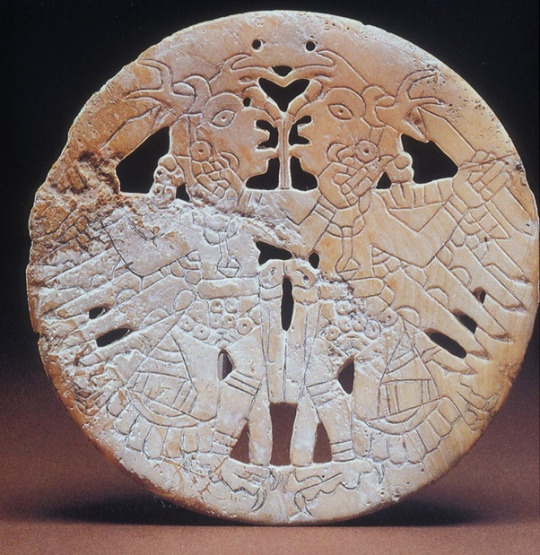
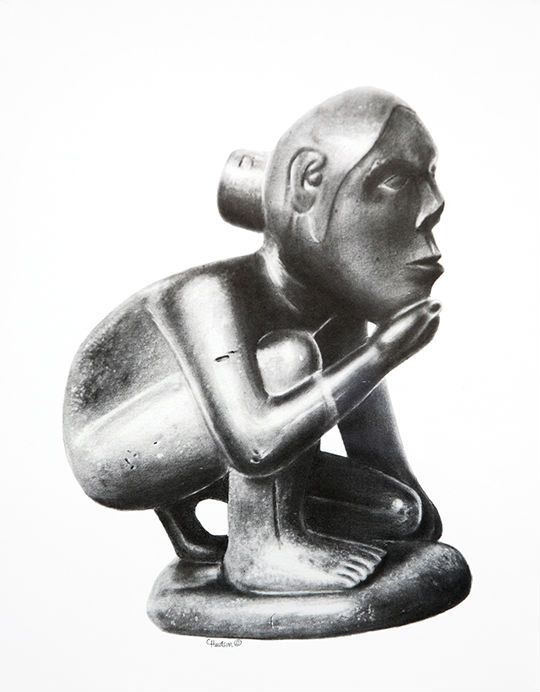
Why did no ancient civilization come up the Mississippi river valley even though it had similar conditions to other river valley civilizations?
Jonathan Hall
, Sapient primate since 1996, enjoys learning about things
Updated Jan 27
· Upvoted by
Roderick White
, PhD Ancient History, University College London (2018)
It really is a pity that even today, despite all the literature, museums and outreach, even the average citizen of the eastern United States is still blissfully unaware of the complex societies whose remnants they often walk or drive right over.
Story time!
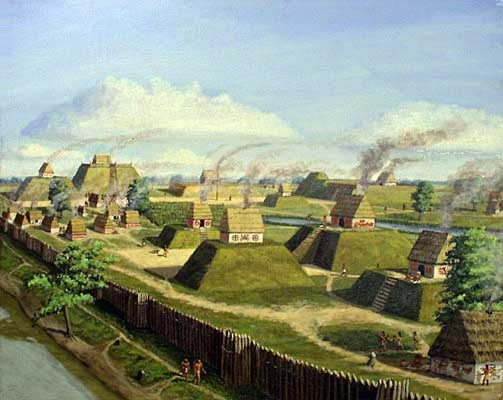
The Eastern Woodlands of the United States has been a nexus for stratified civilization since 3500 B.C. The Mississippi River area was even home to its own independent cradle of agriculture known as the Eastern Agricultural Complex, from which we still have popular vegetables like squash and sunflower. The peoples that farmed these crops have been traditionally termed the “Mound Builders”, so named for their apparent proclivity towards earthworks. The term is a bit dated now, and archaeologists today are able to differentiate specific cultures, but “mound-building peoples” is often still used to describe the cultures in general.
There have been many mound-building societies over the course of North American history. We’ll probably never know the exact political relationships, but we can identify consistencies in material culture and living patterns. The first one that really seems to take off across the board is the Hopewell:
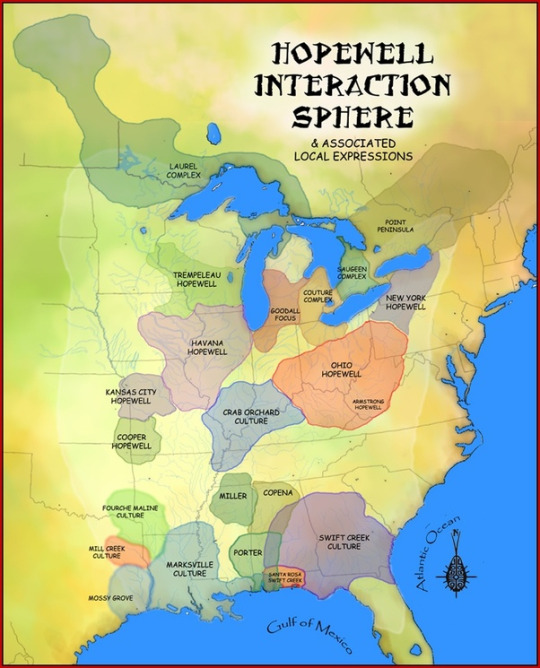
Starting around 100 BC, sites all around the Mississippi start adopting a similar set of traits such as pottery styles, arrowhead techniques and artistic motifs, along with a much more pronounced sense of social stratification. The Hopewell appear to have begun with the Ohio Hopewell, which built upon the stratified Adena culture that existed since 1000 BC on the Ohio River valley, which connects to the Mississippi. The Hopewell greatly proliferate the number of mounds constructed in the Eastern Woodlands and diversify their uses.
One of the most iconic examples of the Hopewell are the Newark Earthworks: a series of interconnected circles, walls and moats that appear to serve as a massive lunar observatory. The Moon’s orbit ‘wobbles’ in relation to the Earth: at one extreme the orbit is rotated one way, and rotated the other way at the other extreme. The point in this cycle where the Moon’s orbital plane reaches its northernmost or southernmost extent before going back to the other is termed the lunar standstill, which produces an effect not unlike the Sun’s solstices. This happens every 18 years, 7 months and almost 10 days. The Newark Earthworks are able to track the Moon’s declination until the next standstill with remarkable precision.
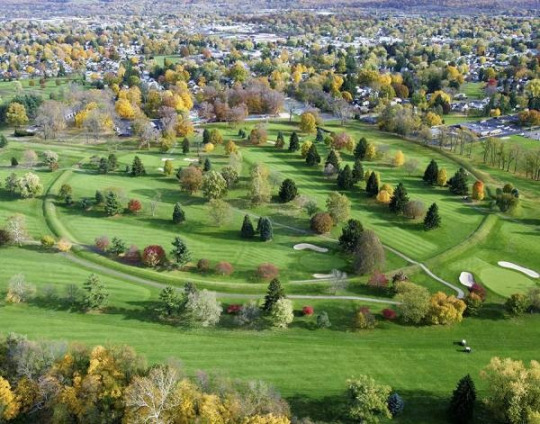
Newark today. A country club still owns parts of the earthworks.
It’s possible that the Ohio Hopewell had such influence over the Eastern Woodlands that they may have started a new religious movement, or perhaps their influence was economical and assimilating their culture was better for business, or people may have simply admired parts of their culture enough to replicate it. A mix of the three may have happened, but we might never know specifically why people wanted to copy them.
What we do know was that their influence was phenomenal. The Hopewell had access to a trade network that extended all the way to the Great Lakes, the Gulf of Mexico and the Rockies, with artifacts from these regions showing up in Ohio:
In the year 500, the bow and arrow trickled southward after being introduced by the Inuit from northern Canada. This makes hunting (and fighting) much more accessible, freeing people up from their dependencies on crops and some hierarchical control.
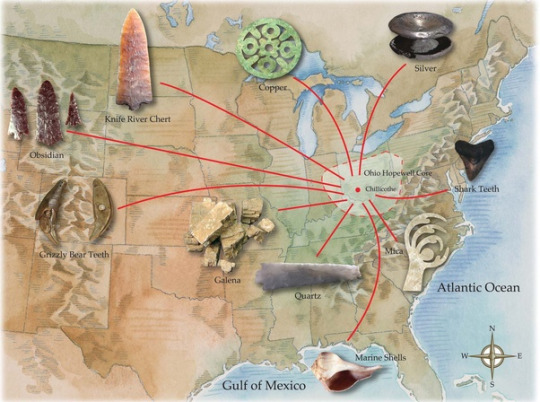
From there the magic begins to die for the Hopewell and the societies within its sphere fall into the geographically broader-ranging Woodland period. The 500 years of the Late Woodland period saw a great intensity in fortification, a significant reduction in mound-building (though some are still built) and more numerous, smaller walled villages instead of the larger towns of the Middle Woodland’s Hopewell. This lifestyle, in some form, actually lasted in the periphery of the Eastern Woodlands until the arrival of Europeans.
By the year 1000, however, something new appears in the heart of the Mississippi. People are once again gathering in large towns and forming wealthy elites under the control of powerful rulers who began using earthworks to proclaim their legitimacy. Corn (maize) was introduced to the Eastern Woodlands in 200 BC, but had a hard time dealing with the colder climates. However, new cold-hardy cultivars had finally been developed and were taking the Eastern Woodlands by storm into a new agricultural revolution. Things were about to get corny.
Archaeologists have given these corn-crazy, mound-building chiefdoms the aptly-named title of the Mississippians:
This is where things really start getting big. The power and influence of chiefs have increased drastically into large, multi-town paramount chiefdoms, though if we’re being completely honest some of these really resemble early kingdoms and the difference is largely semantic. The massive trade networks have fired back up and are bringing in more goods than ever before. They especially love Great Lakes copper. Art, culture and religious expression have also greatly expanded and this cultural movement reaches nearly every corner of the Mississippi River watershed:
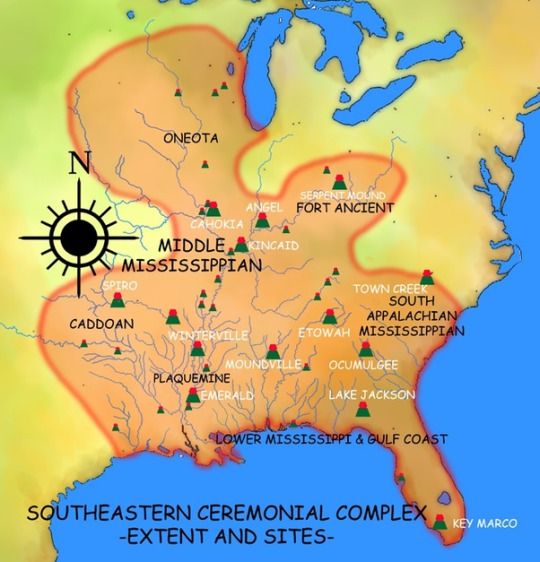
The “Sponemann Figurine” from Cahokia. The headwrap seen on her head has been documented in historical Native American tribes:

Copper plate of a falcon-eyed man from Spiro Mounds, Oklahoma:
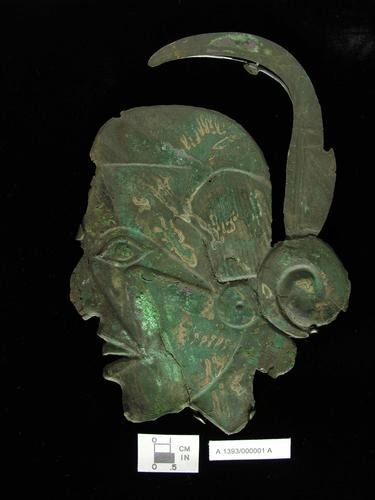
“Crouching Man” effigy pipe from Shiloh Indian Mounds, Tennessee:
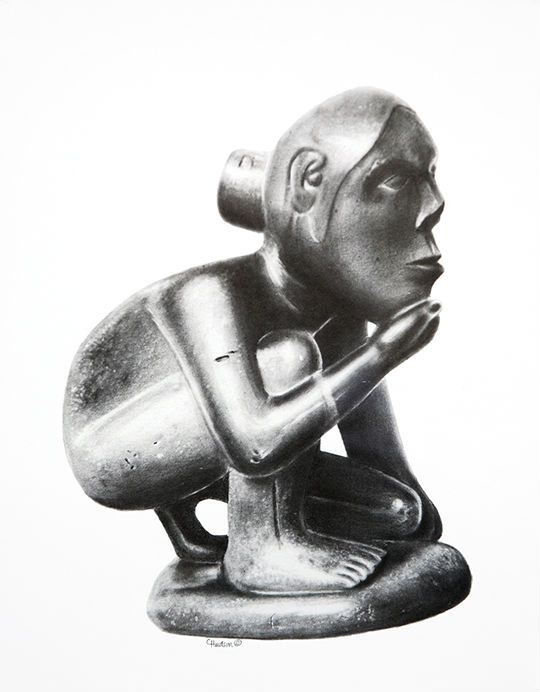
More Spiro copper plate art, including a falcon dancer (or warrior) to the left. These are replicas for Spiro’s museum exhibit:
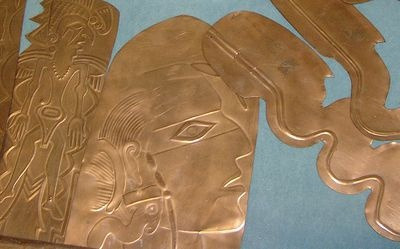
“Conquering Warrior” effigy pipe from Spiro. The wooden slat backshield he is wearing has similarities to the armor worn by Great Lakes tribes, which also protected the head and neck in this way:

Wood duck effigy bowl, diorite. Moundville, Alabama:
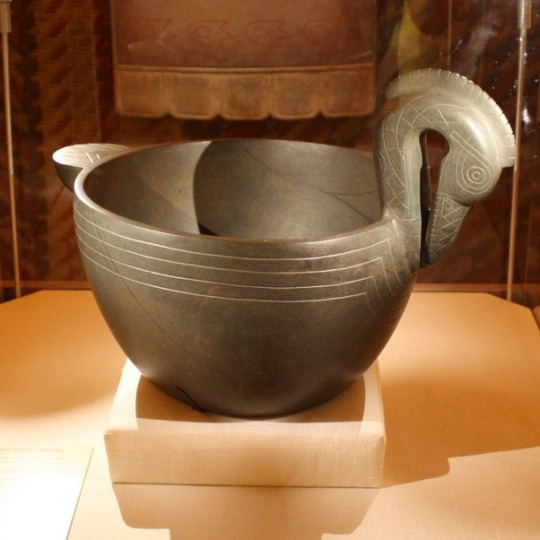
Shell gorget of two dancers from the McClung Museum of Natural History & Culture in Tennessee:
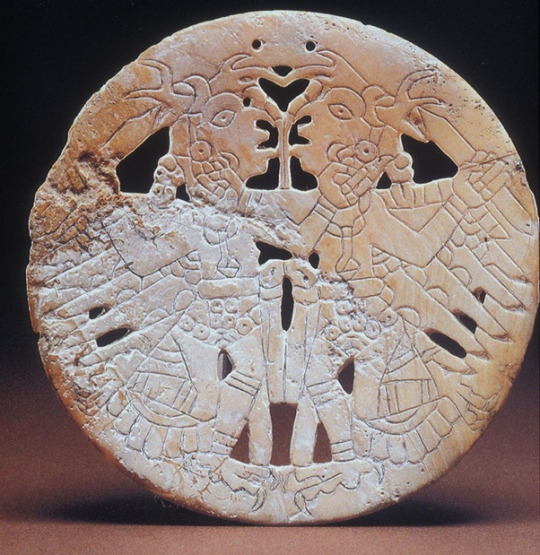
But one of the most profound examples of Mississippian culture, and what everybody wants to see when they visit the sites, are of course the mounds:
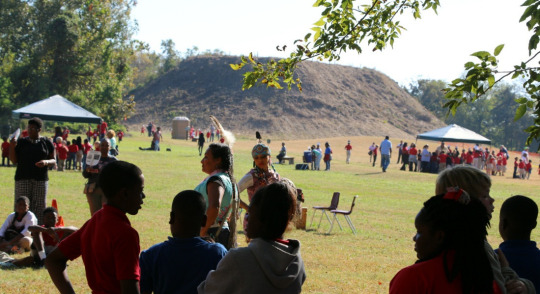
Winterville Mounds, Mississippi
These are no mere piles of dirt either, but alternating layers of various clays and particulates that each have their own physical properties and ostensibly spiritual meanings to ensure the greatest structural stability and proper religious status. Most of these clays were sourced from many miles out, even when a more convenient source was nearby. Most of these mounds were built to house a temple or chief, and the larger mounds served as residential-religious complexes for the elites. When the person living on the mound died, his house was burnt with any of his belongings and a new mound was constructed atop.
The most impressive of these Mississippian mounds, still standing today (in somewhat eroded form) is Monks Mound in the archaeological site of Cahokia:
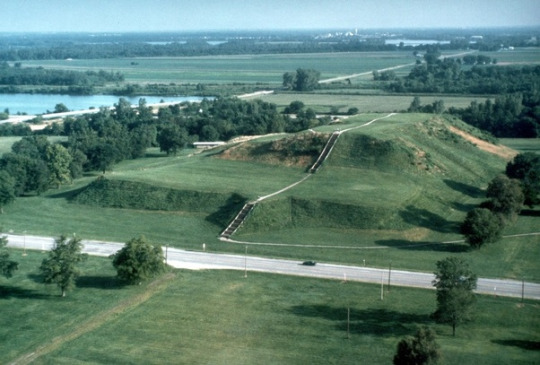
This terraced platform mound is 100 feet high, 775 feet wide, and 955 feet long; slightly larger at the base than the largest Egyptian pyramid.
The mound held multiple large buildings, including that of the paramount chief who overlooked a city we call Cahokia, the largest in pre-Columbian North America north of the Rio Grande, existing from A.D 1050 to 1350.
And there’s a highway right through it…
(A little outdated: there is evidence of clay caps on many Mississippian mounds, which means these mounds would have been a bright yellow or red instead of turf green)
The safe estimate for Cahokia’s population is around 20,000 people, but it has sometimes been given twice that. Either way, it’s reasonably impressive for the area and historical context. Our modern life has made us used to megacities spanning hundreds of thousands or millions of people, but to put 20,000 souls into perspective: This is close to the same size as London in 1200. Berlin was a quaint village of barely over a thousand at this time. Paris had very recently become a medieval metropolis at a hundred thousand people, but had floated at around 35,000 for about a millennium. The modern city of Ithaca, New York is around 30,000.
This city was America’s first melting pot, bringing in peoples from very distant regions who came for trade, religion and safety. The city was organized into districts according to class and sometimes function, including ‘industrial zones’ for production of things like beads, tools, pottery and copper art.
Outside the walled ceremonial district was a “Woodhenge”; a circular arrangement of poles that track the position of the sun like a giant solar calendar. Nearly all of the buildings are aligned to the four cardinal directions; the four directions to this day are important to many Native American tribes. Some pits within the city were dug as a source of clay and, if we can glean from historical accounts of native towns, were likely flooded and stocked with fish.
Cahokia faced many typical issues of a large early city: social order, sanitation, dietary deficiencies, and especially resource exhaustion (good timber had to be brought in from upriver). In finding a reason for Cahokia’s fall, it seems to have dealt with these okay enough. But some time after 1200 AD came an unusually wet era for the Mississippians, and all that extra rainfall drained into and rushed down the Mississippi, which would have drenched all of Cahokia but the tops of its mounds.
Interestingly, the Osage tribe, a Dhegihan-Siouan people that have one of the closest cultural similarities with the archaeological findings of Cahokia, have an origin story that draws many parallels (from Willard H. Rollings’ The Osage: An Ethnohistorical Study of Hegemony on the Prairie-Plains):
. . . in the beginning all of the Osage lived in a single village located along a river. One day the river flooded, and the Osage fled the rising waters. One group made it to the top of a hill, while others fled a nearby timbered ridge. A third group escaped to higher ground and sought shelter in a dense thicket, while a fourth group found refuge at the base of [a] hill just above the floodwaters. Some of the Osage, unable to escape, remained in the flooded village. After the floodwaters receded, the Non-hon-zhin-ga [council] insisted that the people remain in the groups they had formed during the flood. They claimed that Wa-kon-da [the Great Spirit/Mystery] wanted the people to live apart and to establish five villages . . .
After the flooding, Cahokia was still inhabited, but was a shadow of its former self. The people that lived there in the roughly 200 years until its final abandonment seem to have lived without a major elite class and used parts of Monks Mound as a garbage midden. Cahokia, once at the forefront of the Mississippian trade network, seems to have taken the long distance trade with it.
…but that’s not the end!
Mississippian culture was still alive and vibrant in the Lower Mississippi and Southeastern Woodlands (and the Middle Mississippi and Ohio River too, but the other places are more intense). However, times have changed. The lack of the Cahokian trade nexus has wrecked regional economies. Influence vacuums have formed and the world seems just a bit more dangerous. This is where history begins to rhyme a bit: there is an increase in fortification and town splitting, though not quite to the same degree. Towns are typically surrounded by a defensive wall and people move if the population gets too big, but complex hierarchies and earthworks are more active than ever. The political climate of the Southeast leads to the creation of vast open territories, with areas of dense wilderness serving to buffer the territories from large military campaigns (though light travel is still possible on trails). These territories, of course, had to be managed. And it’s during this era that we are finally able to know how the Mississippians governed themselves, at least in some parts, due to the accounts from Hernando de Soto’s entrada. In the Southeast among Muskogean (Creek) towns, the major town leader (potentially the paramount as well) was the mico/micco. Subordinate to the mico are the orata, which governed satellite towns. The iniha/heniha was an administrator served along the mico as a kind of magistrate and the yatika was the official translator. Each of these large territories was an italwa, and this word was also used to describe the largest towns ruled by micos, talofa being the smaller towns. The Caddo Mississippians in Texas and Oklahoma had the same structure, despite being on the other side of the Mississippian sphere.
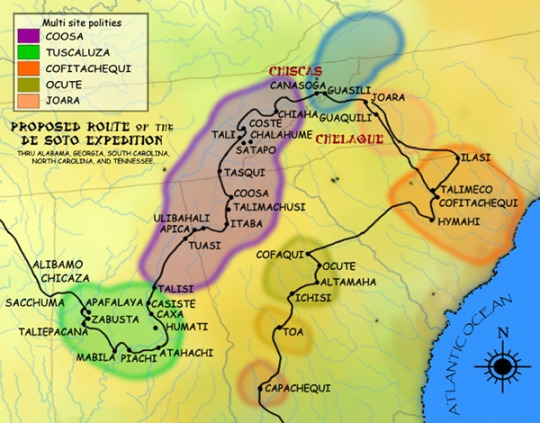
Hernando de Soto’s route through areas that are known Mississippian polities. There are more archaeological sites than shown here which could possibly represent other polities.
Starting from Florida, Hernando de Soto and his entrada entered Mississippian civilization, starting with the Appalachee (to the south, off-screen of the map) and into the Mississippi River proper. There they found large capitals with their mounds and walls, and many towns had other features such as moats and levies. Some of these moats seem to have doubled as fish traps, according to de Soto’s secretary Rodrigo Ranjel who described Pacaha’s (probably the Nodena site in Arkansas) moat as ”full of excellent fish of divers kinds”.
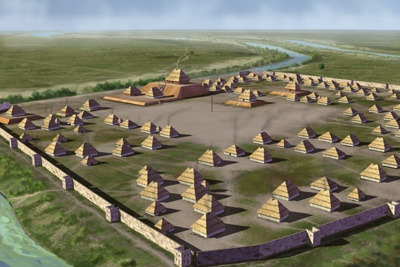
The Parkin site in eastern Arkansas, one of the places visited by Hernando de Soto
You will often hear that from here, Hernando de Soto’s very existence caused 90% of the natives to keel over from European diseases. However, there is actually no evidence of such mass deaths, even in towns that had Spanish artifacts. To make matters even more interesting, De Soto and some other Spaniards actually fell ill and died on this journey, at a point in the journey longer than the incubation period of known European diseases, with the natives unaffected!
But the entrada still had a devastating effect on the political atmosphere. In his search for gold and the desire to continue such a journey, de Soto raided and burned towns, forcibly occupied capitals and even kidnapped paramount chiefs — people who were supposedly of heavenly descent, reduced to being bound and caged for ransom. He used his influence to alter Mississippian political relationships to his benefit and this wrecked the status quo. The paramountcies of Coosa and Cofitachequi no longer had the same kind of respect, influence and control over their territories as they once had. Political cohesion was now much more tenuous.
The entrada would not be able to walk away from the Eastern Woodlands so easily, however. Shortly before he died, de Soto tried to use his claim as son of the Sun to force the chiefdom of Quigualtam, the largest and most powerful polity of the lower Mississippi, to give them safe passage down the Mississippi…and some tribute for the road, of course. Quigualtam wasn’t buying it. After a failed overland route near Texas, De Soto’s entrada (now led by Luis de Moscoso) built some ships and tried to sail down the Mississippi as quick as humanly possible.
Quigualtam, of course, caught up with them. The small Spanish river fleet was met by Quigualtam’s fleet of nearly a hundred canoes, many of which held up to 70 people. These large canoes had awnings in the back housing the commanders; the awnings, paddles, weapons, and the boats themselves were all one color, with a different color for each boat. They sang and drummed in unison to pace their paddling; most of the songs could be summed up as “You Spaniards sure are in for it now!”. There was, naturally, a very loud scream at the end of each song.
Once the boats got close, teams of divers jumped off the boats and into the water to board the Spanish’s pinnace boats. Other paddlers stood up and began firing volleys. They managed to kill, wound and capture some people, but made the decision not to engulf them entirely — Quigualtam’s plan was not to annihilate the Spaniards, but to harass, exhaust and terrify them enough that they understood who had the real power in the Mississippi, and would tell all of their countrymen back home. Which of course succeeded: every time the Spanish thought they out-sailed Quigualtam, they would hear the shouting again and the terror would start back up.
Quigualtam’s cultural descendants are the Natchez, whose society remained strongly Mississippian well into the historic period, interacting diplomatically with the United States.
Despite this successful expulsion of the Spaniards, it was only the beginning of the end for the Mississippian way of life as a whole. European ships were conducting slave raids all around the North American coast, as well as propping up some natives to become slave raiders themselves, which only expanded ever inward. This led to an increase in warfare, famine and mass uncertainty that undermined the political structure of the Eastern Woodlands, leading to the breakup of most Mississippian polities. It was only when the stresses from raids and starvation was at its peak that the first epidemics begin to sweep through; these events had lowered the immune system of natives. The Native American slave trade continued well into the age of the British colonies and early U.S., where Savannah, Georgia was an important port for the export of Native slaves.
De Soto’s accounts were buried in the libraries of New Spain, records of English colonial interactions with remaining Mississippian polities fell into obscurity, and the survivors of the Mississippian breakup had long since adopted new, somewhat more egalitarian lifestyles. Many of the old Mississippian towns and cities were revisited again as abandoned mounds. Rather than believe they were built by the ‘savage’ Indians they were killing and enslaving, people came up with numerous myths of other more prestigious people who came to America before them, only to be killed off by the current inhabitants. The Aztecs. Hindus. Babylonians. The Lost 13th Tribe of Israel. The Welsh. Anyone but the indigenous people. Thomas Jefferson was one of the first, after archaeological digs of his own, to suggest that the mounds were in fact built by Native Americans.
But the myth had always persisted. In fact, some pseudo-scientific circles to this day still deny the origins of the mounds in favor of their preferred civilization. And the lack of respect Americans have had for the mounds is exhibited by their constant destruction throughout American history. Massive temple platforms were excavated so their clay could be used for road fill or embankments. Some were simply in the way of progress: right across the river from Cahokia was the remains of a smaller city which was nearly completely torn down to make room for St. Louis. Only one deeply eroded Sugarloaf Mound remains. Many Mississippian sites are still on private land, their artifacts routinely dug up by plows while their discoverers don’t think much of it.
This has been simply another front of a campaign as old as the United States itself to destroy and mask the history and culture of Native Americans, so as to put European-American history and culture at the forefront. Today, we are more sensitive to the real history before the United States, and also have the power and resources to protect and educate. But the damage inflicted over the centuries has been done, and we are still reeling from its effects. It will take a while before Americans really truly become aware of their country’s pre-European past and realize it’s something to be celebrated, not quietly ignored. Until then, we should try to educate and raise awareness as much as we can.
As you can see, the Mississippi River did indeed give birth to some quite complex societies. You might also be wondering: why didn’t all this complexity happen earlier? Or reach the political strength of other river valley civilizations?
Well, first off I don’t think you can ever get a detailed answer to that. Many people like to fall on geography as the sole determiner of human society, but humans, as we all know, are complicated and do not like to follow the rules. Nevertheless, while the fertility of the Mississippi watershed can’t be overstated, the region is also perhaps a bit…too fertile. Most other river valley civilizations are in relatively dry areas, with a narrow stretch of fertile floodplain that forces most people to huddle together and submit to a central managing authority. In the Mississippi, you can have great farmland by the river, but you can also go deeper into the many, mazelike tributary rivers into the woods and have almost just as productive a crop. This is harder to keep under control, which narrows the focus of elites for the most part. However, ancient China had much the same layout: a large swath of fertile land under a complex watershed of not one but twogiant rivers. Horses, not available to the Mississippians, may have also played a part in such a difference. Or perhaps simply not enough time has passed since the Eastern Woodland’s adoption of agriculture in 1800 BC and the introduction of more efficient crops in 900 AD. If you’re asking me, a historical particularist, I believe that the fate of human societies can ultimately fall on the decisions made by their communities. The ideologies that led to the creation of sprawling, intensely bureaucratic states simply did not come to fruition in the same way they did in China or Mesopotamia. Maybe that was influenced by the factors I mentioned, or the values were simply different.
Yet a civilization it definitely was, with its own sophisticated cultures, politics, and artistic expression. Like many civilizations, it had its own peaks and dips, and with every dip rose a peak that was stronger than ever before. The collapse of the trade networks after 1400 was a dip the Mississippians had just begun to recover from. Considering the interruption of Mississippian history with the arrival of the Spanish, one has to wonder: what kind of peak might we have seen next?
Further Reading:
Mysteries of the Hopewell: Astronomers, Geometers, and Magicians of the Eastern Woodlands by William F. Romain
Ancient Cahokia and the Mississippians by Timothy R. Pauketat
Medieval Mississippians: The Cahokian World by Timothy R. Pauketat and Susan M. Alt
Mapping the Mississippian Shatter Zone: The Colonial Indian Slave Trade and Regional Instability in the American South by Robbie Ethridge and Sheri M. Shuck-Hall - goes into the political instability caused by European activity that led to the collapse of many Mississippian polities
Epidemics and Enslavement: Biological Catastrophe in the Native Southeast, 1492-1715 by Paul Kelton - also discusses the shatter zone, but builds upon it by touching on the biological aspect. Particularly, it addresses the myth of the spread of European disease in the EW: rather than the wildfire-like instantaneous transmission many imagine, the worst of the epidemics only came about when the immune systems of the natives were weakened through stresses.
The Forgotten Centuries: Indians and Europeans in the American South, 1521-1704 by Carmen Tesser and Charles Hudson - very aptly named; in-depth exposition of the often overlooked protohistoric period, inbetween the jurisdictions of archaeologists and historians.
Amazon.com: Knights of Spain, Warriors of the Sun: Hernando de Soto and the South's Ancient Chiefdoms by Charles Hudson and Robbie Ethridge - Contains actual primary sources of de Soto’s journey, augmented and illuminated by the interpretations of modern historical and archaeological data.
1 note
·
View note
Text
Egypt Honeymoon Package and Vacation
Enjoy the incredible historical sites in Egypt with Egypt Honeymoon Packages, spend your honeymoon in a unique setting with a taste of ancient Egyptian style while taking advantage of Egypt's wonderful warm weather, explore the incredible ancient Egyptian sites and pick up pharaonic mementos for your partner, Enjoy a romantic honeymoon in Egypt surrounded by historical sites because Egypt is home to one of the seven wonders of the world, the Great Pyramids of Giza, which are situated on the Giza Plateau and are one of the most magnificent Egyptian landmarks to see. These fascinating pyramids were built between 2550 and 2490 B.C. during the Pharaonic era.
Try the excellent deal on honeymoon vacations to Cairo and a Nile cruise to explore the most beautiful locations in Egypt while taking a fantastic felucca ride and taking in the natural scenery along the Nile Shores, It is located 20 kilometers south of Cairo and will transport you back in time to learn more about ancient life through visiting Memphis City, Memphis City was one of the most significant towns in Egypt during the Old Kingdom since it served as the king's primary palace and served as the country's ancient capital. The city was built by Pharaoh Menes around 3000 B.C. Additionally, there is the magnificent church Ben Ezra Synagogue, which dates back to the Turkish dynasty and is of great significance to the Egyptian Jews. Ben Ezra Synagogue was built in the shape of a rectangular basilica and has two floors, the first of which was reserved for men and the second for women.
Try Egypt honeymoon trip with a nuptial ceremony to experience one of the most breathtaking locations. The largest island in Aswan is dubbed Elephantine Island because it was formerly a hub for the sale of ivory. At the start of the first dynasty (about 3000 BC), a fortification was constructed on the island to establish Egypt's southern frontier, making it the first defense line in Upper Egypt, Take memorable photos of the magnificent Sphinx for yourself and your friends. The Sphinx is a huge statue with the shape of a lion in its body and the head of a Pharaonic man; it was once thought that the head belonged to the king Chephren. It is one of the magnificent Pharaonic wonders, and it was built in Giza.
Get more information about the incredible honeymoon cruises to Cairo and the Nile by booking one today. Discover 5000 years of civilization by viewing the amazing items housed in the Egyptian Museum, and learn about Egypt's history while touring the Giza Pyramids, the most well-known sight in the entire world. then embark on a luxurious Nile Cruise to explore the breathtaking attractions situated between the ancient cities of Luxor and Aswan.
You may always choose coastal places like Alexandria if you and your companion enjoy relaxing by the water and engaging in water sports. In addition to being reasonably priced, Egypt honeymoon packages to Cairo and Alexandria in these far-off places guarantee that you will share an unmatched romantic experience.
Enjoy exploring Cairo's top sites and learning about the breathtaking Sahl Hasheesh's splendor. Travel back in time to the era of Ancient Egypt and discover the majestic monuments in Cairo, the contemporary capital of Egypt, which features a rich tapestry of historical artifacts, internationally renowned exhibition halls, and mind-blowing structures, making it a cradle of civilization.
Discover Egypt's amazing cities, go on a Cheap Honeymoon Tour to Cairo and Sharm El Sheikh, and more to experience a romantic atmosphere at the lowest prices. Enjoy a snorkeling excursion among coral reefs and colorful fish; Sharm El Sheikh tours will allow you to unwind on breathtaking beaches in a warm environment.
For more info. kindly visit www.maestroegypttours.com
or send your request to [email protected]
Tel : +201001422529
#Egypt Honeymoon Packages#Egypt Honeymoon Tours#Egypt Honeymoon#Egypt Honeymoon resorts#Egypt honeymoon Vacations#Egypt honeymoon holidays#Egyptian honeymoon packages
0 notes
Link
This Tour visits Giza Pyramids, Sphinx, Memphis, Sakkara, Egyptian Museum, Citadel, Coptic Churches, Islamic Cairo, High Dam, unfinished obelisk, Philae temple, Kom Ombo, Edfu temples, Karnak, Luxor Temple, Valley of Kings, Queens Hatshepsut temple, Colossi of Memnon, Abu Simbel temples, Sun Festival at Abu Simbel temple & 5* Nile Cruise
Day 1 – February 18th: Arrive in Cairo to discover the contrasts of this ancient city, myegypttravel.com representative will meet you at Cairo international airport beyond passport control to handle your Egyptian entry visa then will be accompanied to your hotel for check in with free welcome drink. Tonight, relax or enjoy optional evening of out of this world entertainment as we go to the Pyramids for the incredible Sound and Light Spectacular after you will return to your hotel and then the night is at leisure.
Day 2 – February 19th : After your relaxing breakfast at the hotel in Cairo your own private Egyptologist guide will take you to Sakkara that is part of Memphis’s massive necropolis, and the burial site of the most ancient Pharaohs where you will see the first pyramids ever built in Egypt “Step Pyramid of King Djoser that was designed by Imhotep, the ancient Egyptian architect also you will visit the Teti Pyramid and tombs in Sakkara then you will be transferred to Memphis, the ancient Capital of Egypt to visit the colossal statue of Ramses II and nearby a still half-buried Hathor Temple then a relaxing drive to the famous Giza Plateau, home of Egypt’s GREATEST attractions to visit The Great Pyramids, ONE of the Seven Wonders of the ancient world including the Great Pyramid of Cheops, middle pyramids of Chephren and the little one of Mykerinos and The mysterious Sphinx, the Father of Terror for the ancient pharaohs, the tour includes visit to the valley temple facing the great sphinx, with optional visit to the solar boat, this was a boat used to carry the pharaoh’s mummy across the Nile, and then buried at the foot of the pyramid for his use in the afterlife. Your lunch will be included on the way — later on you will be transferred to Giza railway station to catch the sleeper train to Aswan with dinner aboard the train with a relaxing overnight stay. Day 3 – February 20th: Breakfast aboard the sleeper train before arrival Aswan, where you will be met and assisted by myegypttravel.com representative who will transfer you to the hotel for free welcome drink and check in with free time at leisure at your hotel and in Aswan. Tonight, relax or enjoy optional evening of out of this world entertainment as we go to Philae temple for the incredible Sound and Light Spectacular after you will return to your hotel and then the night is at leisure.
Day 4 – February 21st: then you will joina most unique transfer across the Sahara desert to Abu Simbel with direct transfer to your hotel for check in having settled in free time at leisure. Tonight, join us for an optional evening of out of this world entertainment as we go to Abu Simbel for the incredible Sound and Light Spectacular after we will return to our hotel for overnight stay
Day 5 – February 22nd: Breakfast at your hotel and then you will be accompanied by your Private Egyptologist guide to celebrate the Sun Festival (at Abu Simbel temples twice a year February and October) that mark the emperor’s birthday and his ascension to the throne, Celebrated in a big way by the locals, undoubtedly the Sun Festival at Abu Simbel is one of the most uncommon and astounding festivals in the world. Later you will be transferred to Aswan and directly to your hotel for check in with free time at leisure and overnight stay.
Day 6 – February 23rd: Breakfast at your hotel in Aswan: the you will be transferred to sail in traditional style among the rocky isles of the Nile on a traditional felucca to visit the elephantine island and the botanical garden in Aswan for a Romanic trip on the River Nile. Then you will be transferred to embark your Nile River Cruise, where we will enjoy the next 3 nights aboard one of the largest and most luxurious vessels on the Nile river between Aswan and Luxor. Afternoon time you will be accompanied by your Private Egyptologist guide for an exciting tour to the world famous High Dam that was an engineering miracle when it was built in the 1960s. It contains 18 times the material used in the Great Pyramid of Cheops; continue to the granite quarries which supplied the ancient Egyptian pharaohs with most of the hard stone used in pyramids and temples. The quarries still hold the famous Unfinished Obelisk and then you will be taking by motor-boat to island of Egilka visit the majestic Philae temple that was dedicated to the Goddesses Isis. With final optional evening excursion will offer the sound and light show at the Temple of Philae Return to your ship for dinner free time at leisure in Aswan and overnight stay aboard the cruise
Day 7 – February 24th: Before breakfast aboard your Nile cruise you may enjoy the amazing sunset view from your river cruise in Aswan with free time at leisure in Aswan and then sail to Kom Ombo to visit the temple the crocodile-headed God of fertility and creator of the world and then return to your cruise vessel to sail to Edfu where you will be transferred by horse drawn carriage to visit the famous Edfu temple also know as the temple of Horus & Haroeris, the falcon-headed solar war god is the largest and most perfectly preserved of all the Nile temples, back to the Nile cruise by the same way to sail to Luxor with lunch, afternoon tea and dinner aboard your cruise and overnight stay Day 8 – February 25th: Breakfast onboard the cruise, and then you will be moved into the West Bank of the river Nile to visit the two colossal statues of Amenhotep III (Colossi of Memnon), and then visit the Valley of the Kings, where the magnificent tombs discovered, those tombs were carved deep into the desert rock, richly decorated and filled with treasures for the afterlife of the pharaohs, you will visit 3 tombs. Continue the tour to visit the Hatshipsut temple at El Deir El Bahary, this impressive temple dedicated to the Queen Hatshipsut the only female pharaoh rises out of the desert plain in a series of terraces and merges with the sheer limestone cliffs that surround it then back to the cruise for lunch, afternoon tea and dinner aboard your cruise and overnight stay Tonight, if you wish, enjoy an optional sound and light show at the Temple of Karnak Day 9 – February 26th: Breakfast onboard the cruise, and then you will accompanied by your Private Egyptologist guide to visit Karnak Temple, the largest place of worship ever built. Its ancient name Ipet-isut means “the most sacred of places.” The temple, or, more correctly, the complex of temples, was built over more than two thousand years by generation after generation of pharaohs. Within the complex, the great “Hypostyle Hall” is an incredible forest of giant pillars .Then you will be transferred to the majestic Luxor temple which built by Amenhotep III and Ramses II for ritual and festivals and dedicated to the god Amun with free time for shopping in Luxor and then you will be transferred to Luxor train terminal to board your first class sleeper train back to Cairo with dinner and overnight stay onboard
Day 10 – February 27th: Enjoy your Breakfast onboard sleeper train before arriving Cairo, where you will be met and accompanied by your private Egyptologist guide to visit the world-renowned Museum of Egyptian Antiques that was built in neo-classical style designed by the French architect Marcel Dourgnon which exhibits a collection now over 120000 masterpieces ranges from pre-dynastic era, Pharaonic era to the Greco-roman period in Egypt including the treasures of the child King Tutankhamen, Pharaonic Gods and Goddess, optional visit to the mummies room at the Egyptian Museum where you may learn about the Great Egyptian civilization and the mummification art in ancient Egypt. Then you will also visit the Citadel of Saladin that is overlooking the city from the Muqattam Hills and Mohammed Ali Alabaster Mosque inside that was built in Turkish style and very similar to the Blue Mosque in Turkey and simply considered to be one of the landmarks in Cairo whose minaret can be seen from any part of old Cairo then visit the Christian heritage in Coptic Cairo including some of the early religious monuments of the city such as the hanging church or the suspended church this basilica church was named for its location on top of the south gate of the Fortress of Babylon the church became the center of the Christian Church of Egypt you will visit also the famous Jewish heritage in Cairo including Ben Ezra Synagogue the temple contains a Jewish heritage library, containing documents found here in 1896 that describe the economic and social conditions of Jews under Arab rule as well as descriptions of relations between various Jewish sects from there you will be transferred to your hotel for free time at leisure and overnight stay
Day 11 – February 28th: enjoy your Breakfast aboard the train: and then arriving Giza railway station, where you will be met and assisted by myegypttravel.com representative. Enjoy some free time in Cairo and then you will be transferred to Cairo international airport to fly back home
Inclusions:
* Meet and greet service upon arrival and departure * All transfers by Private air-conditioned vehicle through-out trip * Accommodations for 2 nights in Cairo at 5* hotel with breakfast * Accommodations for 2 night in Aswan at 5* hotel with breakfast * Accommodations for 1 night in Abu Simbel at 5* hotel with breakfast * Accommodations for 3 nights on board 5* Nile Cruise with full board * Accommodations for 2 night aboard the 1st class sleeper train on half board * All sightseeing tours * Camel ride around the pyramids in Giza. * Sun Festival at Abu Simbel temple * Lunch during tours * Soft drinks and mineral water during tours. * Private Egyptologist guide. * All hotel and Nile cruise service charges and taxes.
Exclusions:
* Airfare to and from Egypt * Extra of personal nature * Entry Visa to Egypt included and provided upon arrival
Optional Excursions during this tour: * Sound and Light Show at Giza Pyramids * Sound and Light Show at Karnak Temples * Sound and Light Show at Philae Temple * Hot Air Ballooning over the West Bank * Sound and Light Show Abu Simbel Temples
Notes: * Same program is available either in 4 or 3 star hotel * This program is customizable
1 note
·
View note
Text
Egyptian Museum and Giza Pyramids Tour
Enjoy the incredible adventure Egyptian Museum and Giza Pyramids Tour to see the huge Three Pyramids of Giza, Sphinx, and the Valley Temple and take a lot of pictures in the Panorama area to be unforgettable memory with your family, friends or with your lover. As well as Cairo Tours offers you a short visit to the Egyptian Museum to see the magnificent history of Pharos to know more about the Old Civilization. When you decide to explore the ancient Egyptian civilization then you should Try our amazing Egyptian Museum and Giza Pyramids Tour, Egypt is well known of its amazing Pharaonic pyramids, that was constructed since thousands of years ago, as well as you will be excited with each pyramid that has its own story, so, when you come to Egypt you will explore the pyramids of ancient Egypt Pyramids of Giza and Egyptian Museum Tour, as you will get back to the time of Pharaohs and know more about the marvelous construction of the Pyramids. Start your tour with Pyramids of Giza, which one of the seven wonder of the worlds, also were constructed on one of the rockiest plateaus on the banks of the Nile in Northern Egypt, served as the necropolis for the royalty of the old kingdom, the pyramid structure represents the evolution for tomb design, built to endure eternity for another life, Giza plateau are funerary structures of three kings of the fourth dynasty, Comprised of pyramids, tombs complexes and workers' quarters, and the solar boat museum, the great sphinx. Scout around Cheops Pyramid which is one of the seven wonders of the ancient world and stands from 4000 years; it contains approximately 2.3 million stone blocks. Herodotus said that this pyramid was built by more than 100,000 workers and it took about thirty years to be finished, but the other story says that they were farmers who built it instead of farming due to the Nile River flooding; therefore they concentrate their efforts in building this pyramid. Move to explore Chephren Pyramid which is considered to be the second largest pyramid, although this pyramid is smaller than the Pyramid of Cheops but its top gives an illusion of being higher than the Pyramid of Cheops, because of its smooth limestone cap. Get the chance and explore Mykerinus Pyramid which is the smallest pyramid of the Giza Pyramids, as its height is approximately 66 meters Get excited with Giza Pyramids Tour and explore Sphinx which is a truly a mysterious marvel from the days of ancient Egypt. With a body of and a head of a king or god, Sphinx has come to symbolize strength and wisdom, the statue consists of about 2,000 limestone blocks and although the date of its constructions is uncertain, the head of the Sphinx is believed to be that of the Pharaoh Khafre. Get to know more about the Egyptian history and explore the gleaming finds of the Valley Temple in Giza which is considered the oldest stone buildings in Egypt, is located in front of Khafre Pyramid beside the Sphinx, it is characterized by magnificent of engineering, and its distinctive architectural style, it was the main entrance of the complex of the Giza Pyramids and it was also used as a connection between the complex and the Nile River by a canal. Entertain your soul and eyes by watching the beautiful designing of the Valley Temple, as it has a charming designing and there’s a floor that was made of Alabaster and it contains about 23 statues of Chepren but unfortunately just one statue of these statues that has survived, there were also a lot of chambers and some of them were built for the mummification of the king’s body and some for gods. There’s also a Hieroglyphic engraves that tell about the history of this temple. Choose Egyptian Museum Tour and explore the museum which contains the world's most extensive and rare collection of 5000 years of Pharaonic antiquities, beguile your eyes with King Tut Ankh Amun amazing treasures as the Museum contains more than 120.000 masterpieces. The Egyptian Museum holds an incredibly amazing exhibit, which shed light on the Ancient Egyptian glamorous monuments such as, sarcophagi, jeweler, Mummies pottery and of course the magnificent treasure of King Tutankhamen, as well as they discovered The Death Mask of the boy king in its tomb, and they found out that it was made of solid and pure gold, as it was considered as the most amazing object that has ever made. The Museum holds huge two floors, the first one includes the fabulous statues that belong to Ramses II and many Ancient Egyptian rulers, moreover the beautiful ancient make ups, coins, weapons, irrigation tools and military vehicles which were made by Ahmus. Furthermore the great second floor includes many mysterious rooms, such as the room of the animals mummification that has a lot of mummified animals, as well as the marvelous Tutankhamun’s treasure with its brilliant gold. The room holds many objects such as, the crown, death mast and more, there is also the mummies room which includes a lot of Ancient king’s mummies like Amenhotep III, and you will find many other artifacts and antiques such as the large four gilded boxes which fit inside each other, thrones, a beautiful royal toilet seat, an ancient trumpet, as well as the gold funerary mask and sarcophagus. Try Egyptian Museum and Giza Pyramids Tour Flying Carpet Tours Guide will escort you to a ravishing tour to Pyramids of Giza, feast your eyes by visiting Pyramids of Cheops, Chephren and Mykerinus, then your guide will take you to panoramic view of the pyramids, memorable photos available to the three pyramids together, next move to the Sphinx, scout the valley temple, relax by having lunch at local restaurant, after Lunch your tour guide will escort you to the Egyptian Museum which contains amazing treasures of King Tut Ankh Amun, have free time for shopping to buy souvenirs to Friends and Family, finally Flying Carpet Tours Guide will transfer you back to your hotel in Cairo. Included • Pick up and drop off to your hotel in Cairo • Excursion to Giza Pyramids and Egyptian Museum as mentioned at the above program • Entrance fees to the above mentioned sites • English speaking guide at the sites mentioned above • One Lunch at local restaurant in Cairo • Bottle of Mineral Water during Cairo Excursion • All transfers in Cairo by air-conditioned Van Excluded • Visa to Egypt • Any optional tours required • Tipping
For more info about Egyptian Museum and Giza Pyramids Tour: E-mail: [email protected] Website: www.flyingcarpettours.com Tel.: +201099906242
#giza pyramids tour#egyptian museum#egyptian museum tour#egypt museum tour#trips to egypt pyramids#egypt pyramids tour#cairo pyramids tour
0 notes
Text
22 ancient Pharaohs have been carried across Cairo in an epic 'golden parade'
https://sciencespies.com/humans/22-ancient-pharaohs-have-been-carried-across-cairo-in-an-epic-golden-parade/
22 ancient Pharaohs have been carried across Cairo in an epic 'golden parade'
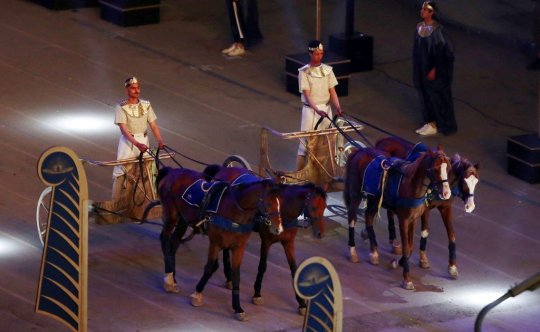
A procession of floats carried the mummified remains of 22 pharaohs, including Egypt’s most powerful ancient queen, through Cairo Saturday evening, in an eye-catching parade to a new resting place.
Under hefty security, the mummies were driven on floats seven kilometers (four miles) across the capital from the iconic Egyptian Museum to the new National Museum of Egyptian Civilisation.
Dubbed the “Pharaohs’ Golden Parade”, the 18 kings and four queens travelled in order, oldest first, each aboard a separate vehicle decorated in ancient Egyptian style.

(Ahmed Mahmoud/Sputnik/AFP)
Both pedestrians and vehicles were barred from Tahrir Square, site of the current museum, and other sections of the route.
Images of the slick parade and an equally carefully choreographed opening ceremony were broadcast live on state television, to rousing music.
The mummies entered the grounds of the new museum to a 21-gun salute, after a slightly shorter than expected journey time of around half an hour.

(Ahmed Mahmoud/Sputnik/AFP)
“This grandiose spectacle is further proof of the greatness… of a unique civilization that extends into the depths of history,” said President Abdel Fattah al-Sisi just ahead of proceedings.
Seqenenre Tao II, “the Brave”, who reigned over southern Egypt some 1,600 years before Christ, was on the first chariot, while Ramses IX, who reigned in the 12th century BC, brought up the rear.
Another great warrior, Ramses II, who ruled for 67 years, and Queen Hatshepsut, the most powerful female pharaoh, were also on the short voyage.
Emblazoned with the name of their allocated sovereign, the gold and black colored carriages were fitted with shock absorbers for the trip, to ensure none of the precious cargos were accidentally disturbed by uneven surfaces.
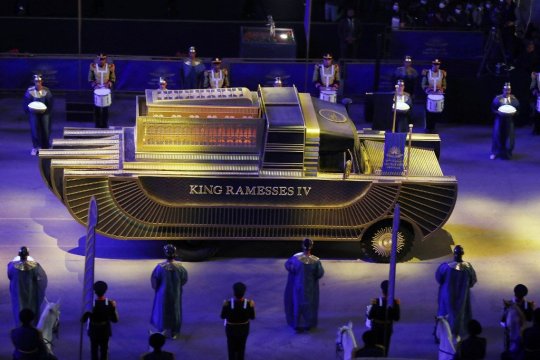
(Ahmed Mahmoud/Sputnik/AFP)
‘Upgraded cases’
Discovered near Luxor from 1881 onwards, fascinating new details of the pharaohs’ lives – and deaths – are still emerging.
A high-tech study of Seqenenre Tao II, involving CT scans and 3D images of his hands and long-studied skull fractures, indicate he was likely killed in an execution ceremony, after being captured in battle.
For their procession through Cairo’s streets, the mummies were placed in special containers filled with nitrogen, under conditions similar to their regular display cases.

(Mahmoud Khaled/AFP)
The new resting place, the National Museum of Egyptian Civilisation in the Fustat district of Old Cairo, consists of sleek, low-rise buildings topped with a pyramid amid expansive grounds.
The mummies will undergo 15 days of laboratory restoration before they are showcased individually in their new home, in an environment redolent of underground tombs.
They will be accompanied by a brief biography.
In their new home, they will occupy “slightly upgraded cases”, said Salima Ikram, professor of Egyptology at the American University in Cairo.
Temperature and humidity control will also be enhanced.
The “museum has what it takes to preserve (mummies), the best laboratories… it is one of the best museums we have,” Waleed el-Batoutti, adviser to the tourism and antiquities ministry, told state television.
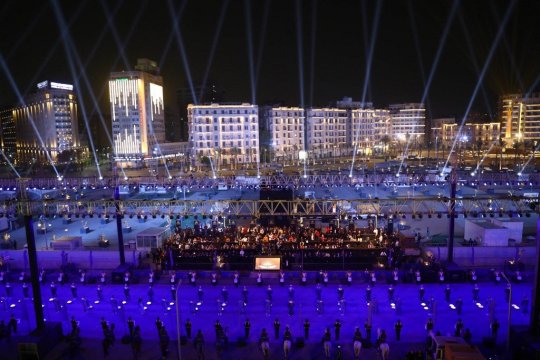
(Ahmed Mahmoud/Sputnik/AFP)
‘Curse of the Pharaoh’
The National Museum of Egyptian Civilisation opened its doors to limited exhibits from 2017 and will open fully on Sunday, before the mummies go on display to the general public two weeks later.
In the coming months, the country is due to inaugurate another new showcase, the Grand Egyptian Museum, near the Giza pyramids.
It too will house pharaonic collections, including the celebrated treasure of Tutankhamun.
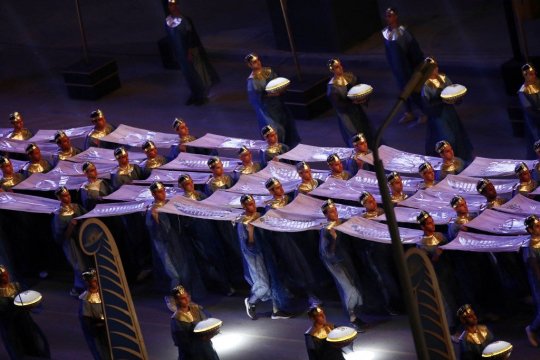
(Ahmed Mahmoud/Sputnik/AFP)
Discovered in 1922, the tomb of the young ruler, who took the throne briefly in the 14th century BC, contained treasures including gold and ivory.
A so-called “curse of the pharaoh” emerged in the wake of Tutankhamun’s unearthing in 1922-23.
A key funder of the dig, Lord Carnarvon, died of blood poisoning months after the tomb was opened, while an early visitor likewise died abruptly in 1923.
With the parade coming only days after several disasters struck Egypt, some inevitably speculated on social media about a new curse provoked by the latest move.
The past days have seen a deadly rail collision and a building collapse in Cairo, while global headlines were dominated by the struggle to refloat the giant container ship MV Ever Given which blocked the Suez Canal for almost a week.
The mummies’ re-housing “marks the end of much work to improve their conservation and exhibition,” said UNESCO Director-General Audrey Azoulay, who was in Cairo for the parade.
“This raises emotions that go much further than the mere relocation of a collection – we will see the history of Egyptian civilization unfold before our eyes.”
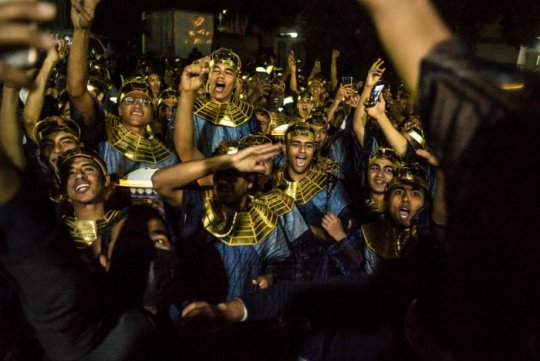
(Vassilis A. Poularikas / NurPhoto / NurPhoto via AFP)
Who are the pharaohs who moved home in Cairo?
Here is a list of the pharaohs being rehoused at the National Museum of Egyptian Civilisation and a description of each.
1 – Seqenenre Tao II, known as “the Brave”, he reigned over southern Egypt some 1,600 years before Christ and led a war against the Hyksos, a Semitic people who had invaded the country.
2 – Queen Ahmose-Nefertari, his powerful and influential daughter, she was married to her brother Ahmose I who was the first monarch of the 18th Dynasty.
3 – Amenhotep I, second pharaoh of the 18th Dynasty, he was a child when he became king and ruled with the help of his mother, Queen Ahmose-Nefertari.
4 – Ahmose-Meritamun, Ahmose-Nefertari’s daughter, she was both the older sister and wife of Amenhotep I.
5 – Thutmose I, the third pharaoh of the 18th Dynasty, he ascended the throne after Amenhotep I died without an heir and helped expand Egyptian rule in the south.
6 – Thutmose II, son of the previous king, married his half-sister Hatshepsut.
7 - Queen Hatshepsut, known as the “foremost of noble ladies”, she declared herself pharaoh although in ancient Egypt women could not accede to that role. But she rose to become a powerful monarch under whose rule numerous projects were built and trade with other countries flourished.
8 – King Thutmose III was remembered as one of the great warrior kings of the New Kingdom, whose battle at Megiddo is considered a model of military strategy.
9 – King Amenhotep II, his son, was known as an excellent charioteer and all-round athlete as well as skilled with bow and arrow.
He secured Egypt’s borders and fought military campaigns that secured immense wealth and power, and was also known for expanding the Karnak temple complex near Luxor.
10 – Thutmose IV, son of the previous king.
11 – Amenhotep III ruled for 37 or 38 years. His reign was known for its opulence and the grandeur of its monuments, including the Colossi of Memnon – two massive stone statues near Luxor that represent him and his wife.
12 – Queen Tiye was married to Amenhotep III.
13 – Seti I, son of Ramses I, ruled for at least 21 years during which he led several military campaigns to reimpose Egypt’s authority outside its borders.
His activities and victories were recorded in the temple of Amun at Karnak. His tomb in the Valley of the Kings is one of the best preserved royal sepulchres with vivid colours.
14 – Ramses II ruled for 67 years during which he was known as a great warrior and prolific builder who ordered the construction of temples across Egypt, including the famous Abu Simbel and the Ramessseum, his mortuary temple.
15 – King Merenptah, son of Ramses II, ruled 11 years.
16 – King Seti II, son of King Merenptah.
17 – King Siptah came to the throne during the 19th Dynasty as a child and his stepmother Taworset, wife of Seti II, acted as regent.
18 – Ramses III, king of the 20th Dynasty, was known as the last of the great warrior pharaohs of the New Kingdom.
Several papyri recount a so-called “harem conspiracy” involving high officials by his wife, minor queen Tiye, plotting to kill him to put her son Pentawer on the throne.
CT scans of his mummified body have shown that the king’s throat had been cut from behind.
19 – Ramses IV succeeded his father Ramses III but only ruled for six or seven years.
20 – Ramses V ruled for only about four years and died without an heir to the throne.
21 – Ramses VI, one of the sons of Ramses III, ruled for eight years.
22 – Ramses IX was the eight king of the 20th Dynasty who ruled for about 18 years.
© Agence France-Presse
#Humans
0 notes